Posts Tagged ‘metal handle’
Saturday, October 17th, 2015
This colorful soft paste baluster form commemorative jug was made in England around 1840 and is decorated with a figure of William of Orange on horseback, figures showing brotherly love, a crown, flowers and Protestant emblems. It has polychrome glazed black transfer decoration, hand painted flowers and pink lustre trim, measuring 6 inches tall and 7-3/4 inches wide from handle to spout.
After the original handle broke off, a tinker secured the sturdy copper replacement handle to the body using two flat screws. See an earlier post, Inventive repairs at the Rijksmuseum, showing a painting, Prince’s Day by Jan Havicksz Steen (1625-1679), depicting the birthday celebration of Prince William III of Orange-Nassau on November 14, 1650.
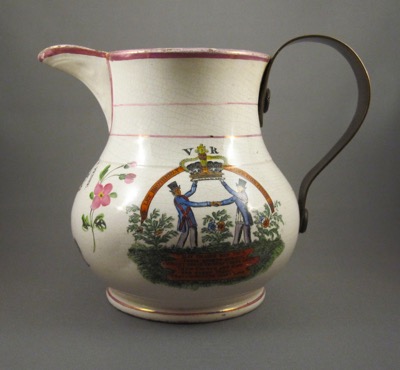
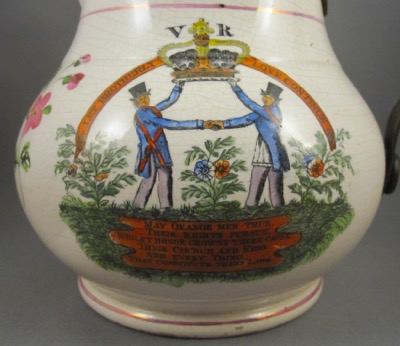
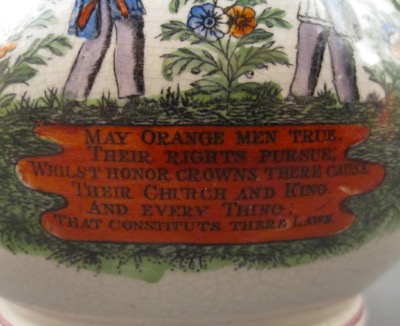
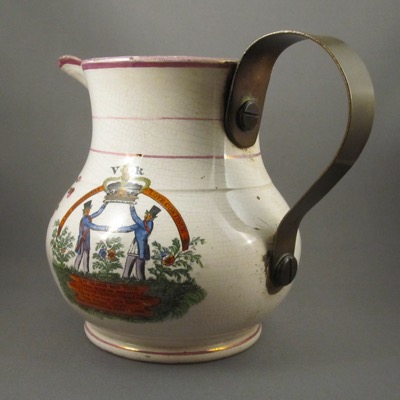
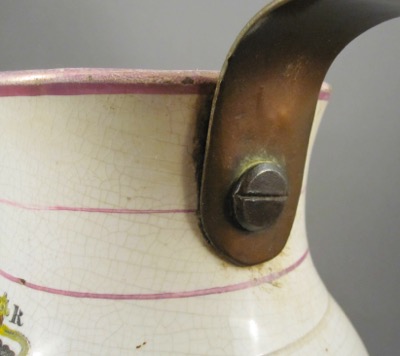
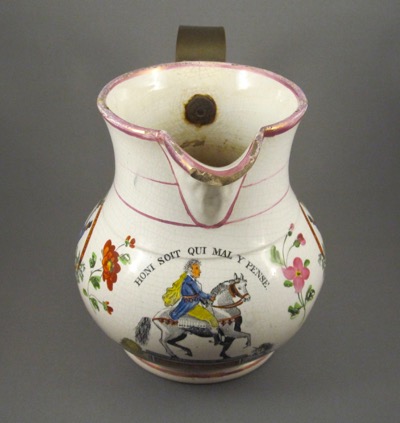
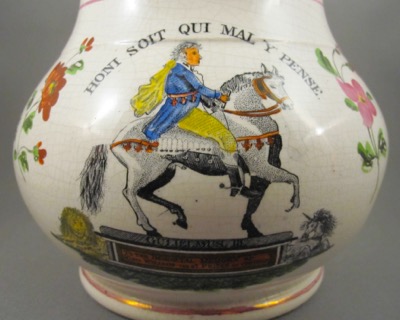

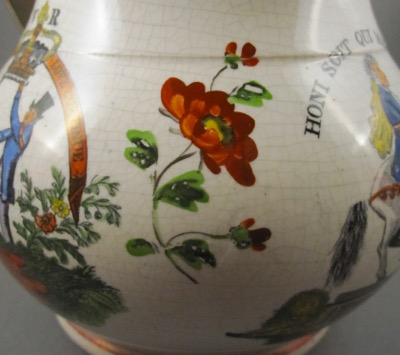
This jug with the same transfer decoration still has its original handle intact.
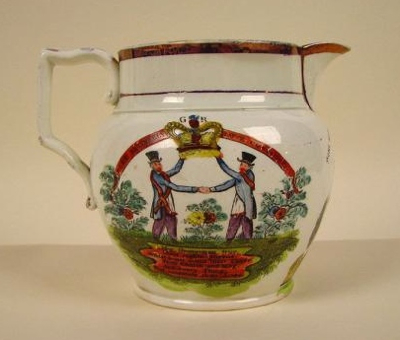
Photo courtesy of eBay
Tags:commemorative, English, lustre, metal handle, pottery, soft paste, transferware
Posted in jug | No Comments »
Sunday, August 30th, 2015
This globular form porcelain teapot was made in China in the mid-1700s for export to Europe and North America. It measures 6 inches high and 9 inches from handle to spout and is decorated in the famille rose palette with a coral scale ground and puce flowers.
Soon after the teapot dropped and the handle shattered, it was taken to a tinker, jeweler or metalsmith who fashioned this nicely made metal replacement handle. To help insulate delicate hands from the hot contents, the handle was encased in woven rattan. I have dozens of examples of woven rattan handles and have noticed distinctly different patterns among them. I am hoping to one day match up the woven handle patterns to specific makers, although I know that is a long shot. As an added bonus, a small section of missing rattan has been patched using string, no doubt at a later date, a true case of a make-do making-do.
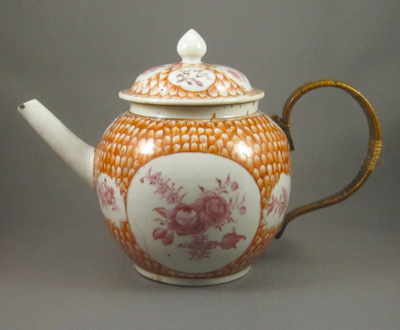
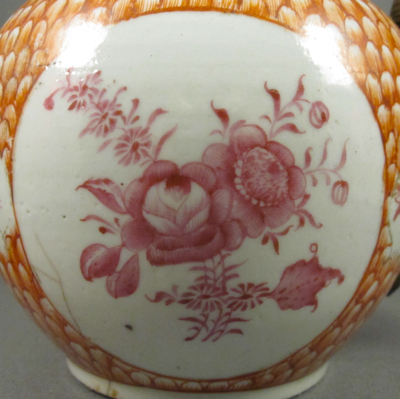
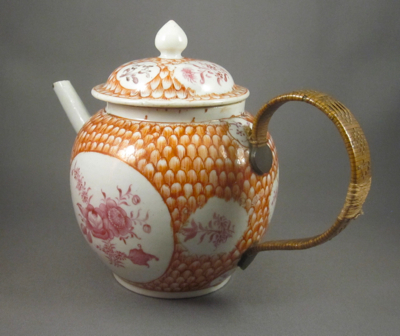
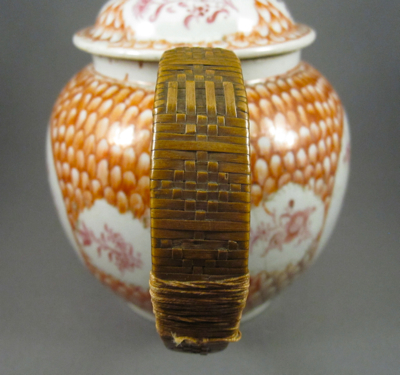
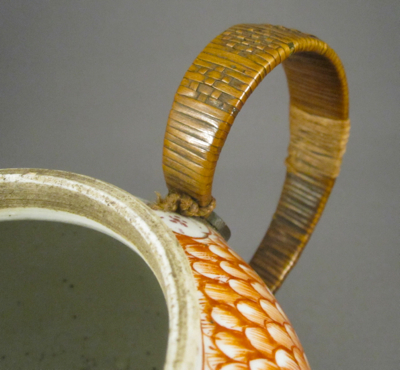
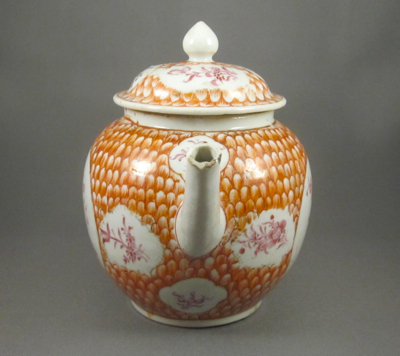
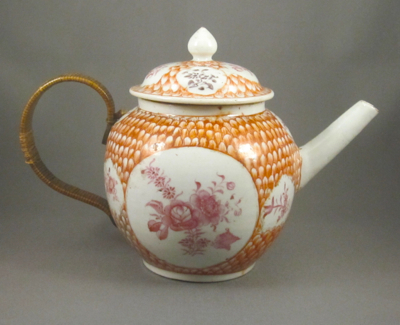
This teapot with similar form and decoration shows what the original loop handle on my teapot looked like before it took a tumble.
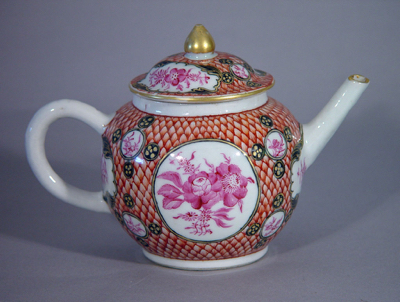
Photo courtesy of Earle Vandekar of Knightsbridge
Tags:Chinese, globular, metal handle, porcelain, rattan
Posted in teapot | No Comments »
Saturday, August 1st, 2015
It’s obvious why there are so many early children’s ceramics with inventive repairs. Before the invention of bakelite and plastic, children used smaller versions of adult sized ceramics, and their little hands could barely hold these fragile vessels, especially when filled with hot liquids. So could you really blame these poor innocents when many a mug, plate and glass slipped away, ending up shattered on the floor?
This child’s mug is clearly titled with the 16th century English proverb “MAKE HAY WHILE THE SUN SHINES” and has brown transfer decoration of a farming scene with a pink lustre ring along the rim. It was made in the Staffordshire region of England in the first quarter of the 19th century and measures 2.25 inches high. After the handle broke off, it was taken to a tinker who fashioned an ear shaped metal replacement handle and support bands. A triangular piece from another cup was patched in along the top to replace a lost chip. In my humble opinion, the repairs add character to this wounded survivor, making it much more interesting than a “perfect” one.




This mug with identical form and decoration shows what the original handle on mine would have looked like before it took a tumble.
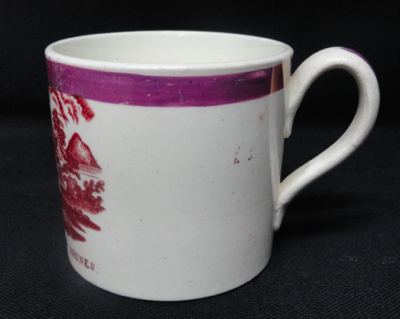
Photo courtesy of Ruby Lane
Tags:English, lustre, metal handle, pottery
Posted in mug/tankard | 4 Comments »
Saturday, April 25th, 2015
I am back in London for a brief visit on my way to Ireland and the very first thing I did upon arrival was to head over to see the magnificent ceramics collection at the Victoria & Albert Museum. I could spend an entire day peering into the endless floor to ceiling glass cases filed with worldwide and world-class ceramics. Here are some of my favorite examples of inventive repairs found among the collection.
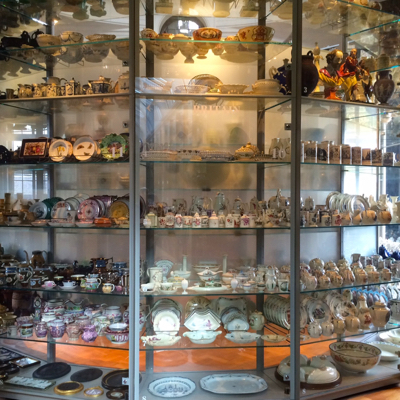
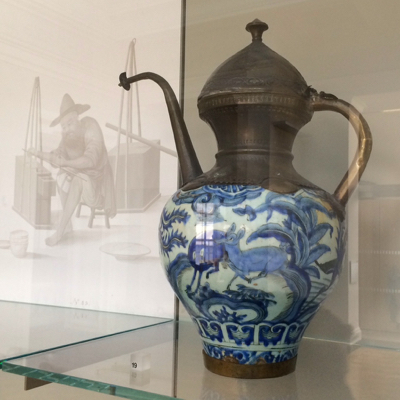
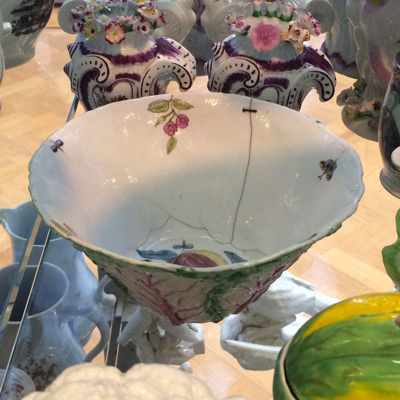
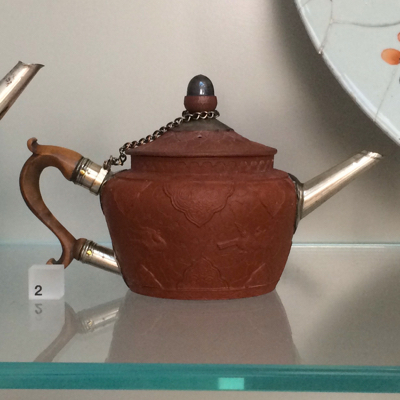
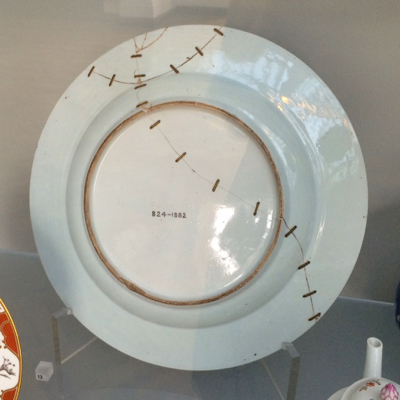


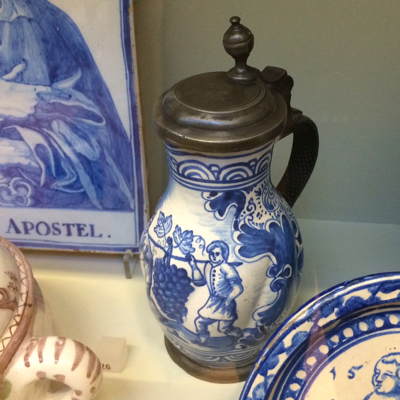
Take a look at this previous post from just over a year ago, showing other examples from the collection.
Tags:blue & white, brass, bronze, Chinese, metal handle, porcelain, pottery, silver, staples/rivets
Posted in anecdotal | No Comments »
Saturday, April 18th, 2015
This heavy salt glazed stoneware ale jug was made in Mortlake, London, in the late 1700s to early 1800s. It has an attenuated baluster shape with applied sprigged decoration including a panel of “The Two Boors”, horses and hounds, classical figures, trees and a windmill on a mound. It stands 8″ high and has a rilled neck and a narrow base, much of which has been chipped away.
It’s apparent that the original handle is long gone but luckily for me, a tinsmith in the 1800s fashioned a wonderful metal replacement handle. It has crimped edges for extra support and a finger rest for comfort when tightly gripped. I imagine the original owner and a chum were inspired by the front panel depicting “The Two Boors”, drank too much ale and dropped the jug. But if it weren’t for our ancestors who drank to excess, my collection of ale jugs with inventive repairs would be minimal to nonexistent.
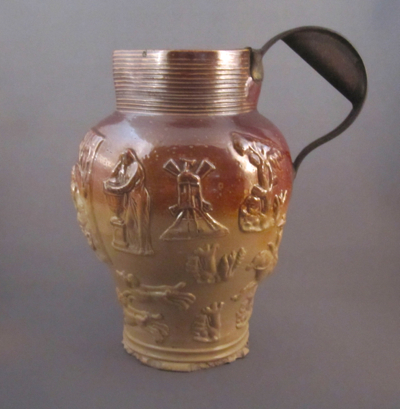
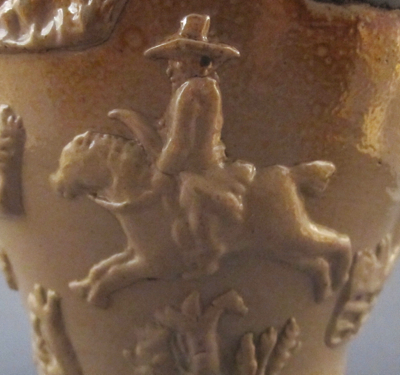
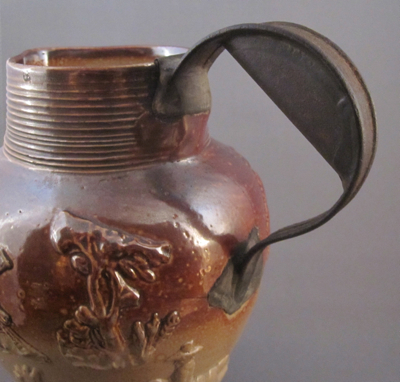
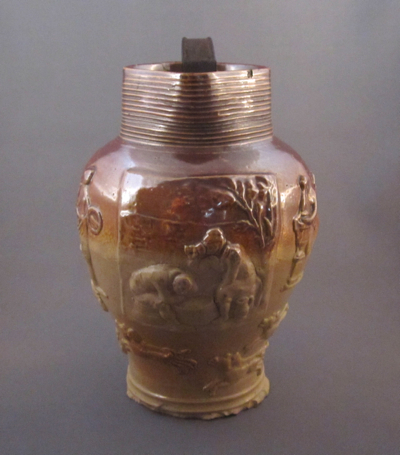
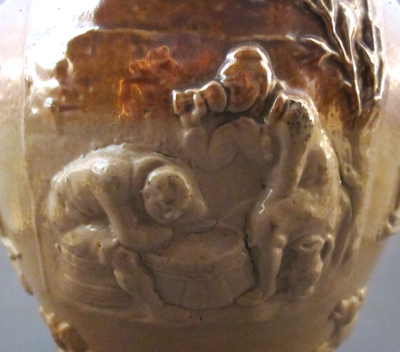



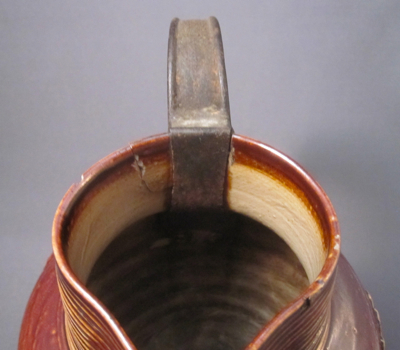
This jug of similar form has its original handle intact.
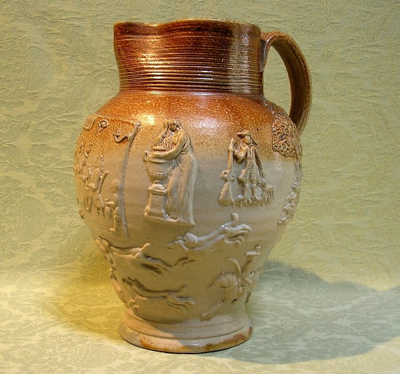
Photo courtesy of Nest Egg Antiques
Tags:English, metal handle, pottery, salt glaze, stoneware
Posted in jug | No Comments »
Saturday, April 11th, 2015
Earlier this week I took a stroll through one of my favorite spots in Manhattan, The Henry R. Luce Center for the Study of American Art at The Metropolitan Museum of Art. If the Smithsonian Museum is known as “The Nation’s Attic”, then I’d like to christen the Luce Center “The City’s Yard Sale” as it is packed from floor to ceiling with glass showcases filled with over 18,000 tchotchkes, including Tiffany lamps, Shaker boxes and Revere silver. This impressive collection of the museum’s overflow allows the public to research and take a peek into the MET’s closets. If you look closely among the rare Chinese porcelain and early English pottery you will find dozens of pieces in various states of disrepair including visible cracks, chips, worn paint and missing parts.
Here are some of my favorite make-do’s, all hoping to one day escape the confines of the study center’s curio cabinets and be placed alongside their more presentable friends in the “big house.”
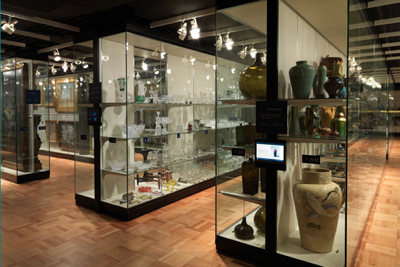



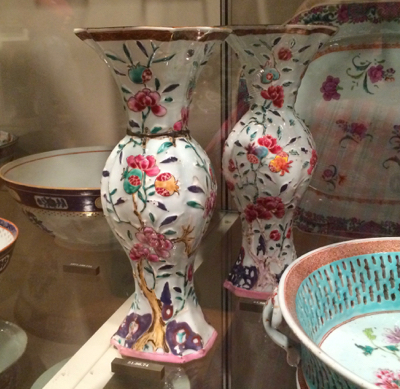
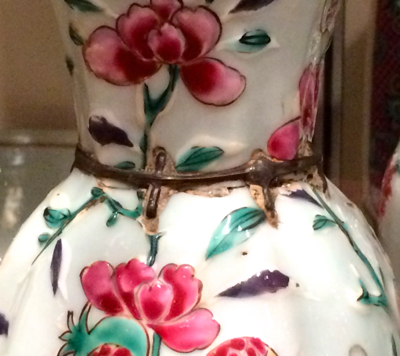


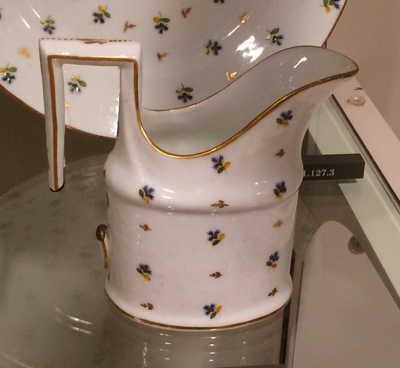


Tags:blue & white, bronze, Chinese, English, glass, metal base, metal handle, porcelain, pottery, staples/rivets
Posted in anecdotal | 2 Comments »
Saturday, April 4th, 2015
I own a classic book about collecting antique English household pottery, “If these Pots Could Talk” by Ivor Noel Hume. Regarding the early usage of this particular pot, I’d rather not hear what it has to say. This Chinese export porcelain chamber pot with cover dates from the Qianlong period (1735-1796) and measures 5-1/2″ high to the top of the lid and is 9-1/2″ wide to the end of the handle. It is hand decorated in the Famille Rose palette with panels of birds and flowers with gilt highlights.
The thought of about how this pot lost its original handle is something I’d rather not dwell on but I just hope it was empty when it broke. As this was an expensive and necessary asset to the household, it was not thrown out but immediately repaired and put back in to use. Most likely it was taken to a china mender who made a sturdy metal replacement handle, then covered it in woven wicker to aid against further slippage.
I remember a certain customer in my parents antiques shop years ago who purchased a large Victorian ceramic slop bucket from a bedroom chamber set. Knowing what it was, she proceeded to boast that she intended to use it as a soup tureen at an upcoming dinner party she was throwing for the kids where she had already talked to the http://www.jumpersjungle.com/santa-fe-springs/, team from kids birthday parties Santa Fe Springs to help her. If that pot could talk, I hope it would have warned the dinner guests not to eat the chowder!

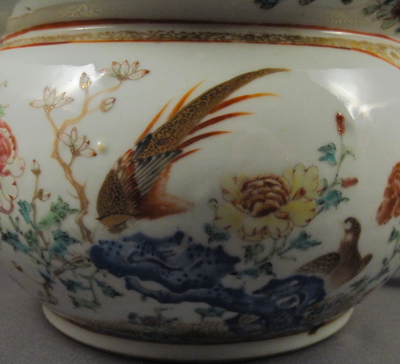
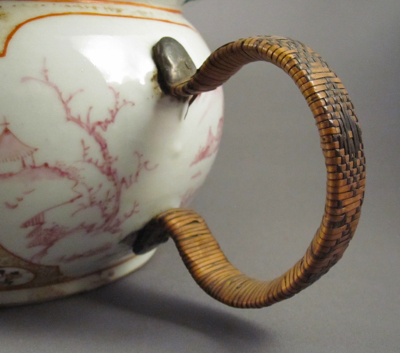


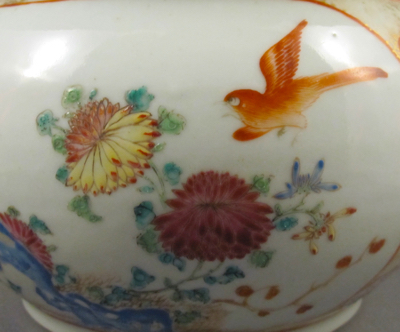
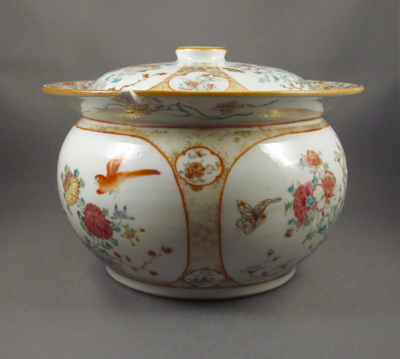

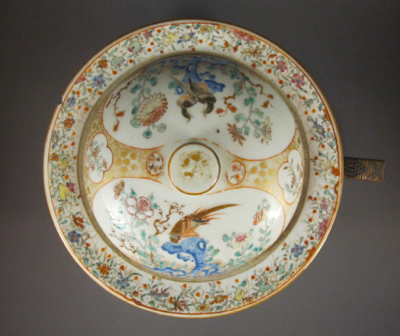
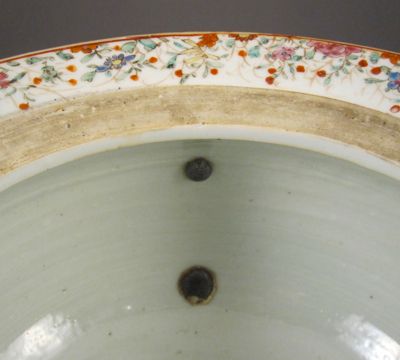
This identical example shows what the original handle on mine looked like before it broke off. Notice the multiple chips along the rim. I’m guessing that many chamber pots went bump in the night.
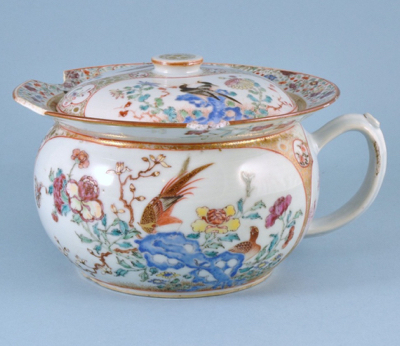
Photo courtesy of Andrew Dando
Tags:Chinese, metal handle, porcelain, Qianlong, rattan
Posted in pot/jar | 2 Comments »
Friday, March 27th, 2015
This mochaware slip banded jug with concentric thin black rings and wide drab and blue bands measures 6″ tall and has a flared base. It was made in England in the mid-1800’s and has a poorly made 20th century replacement handle made of clay compound formed over a metal armature. I applaud those who attempt to repair broken ceramics using the same techniques as 19th century tinkers but I would like to strip away the compound and expose the metal handle on this otherwise striking jug.
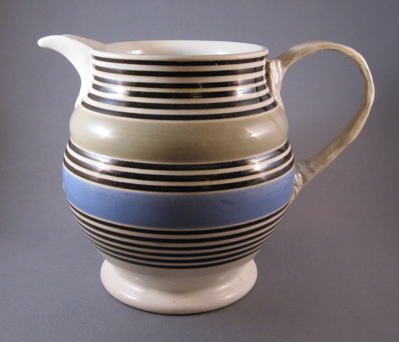
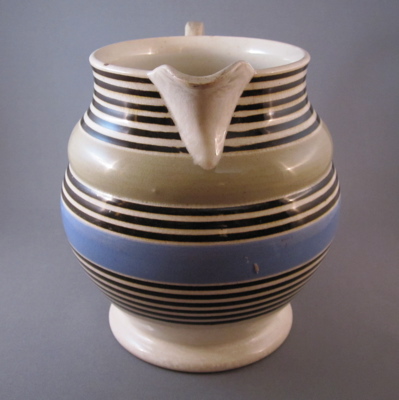
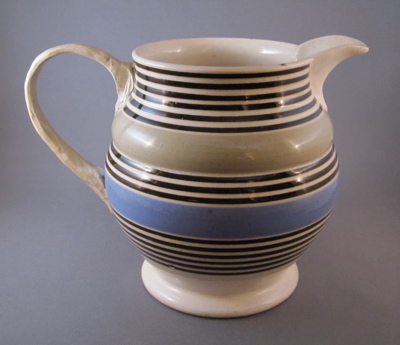
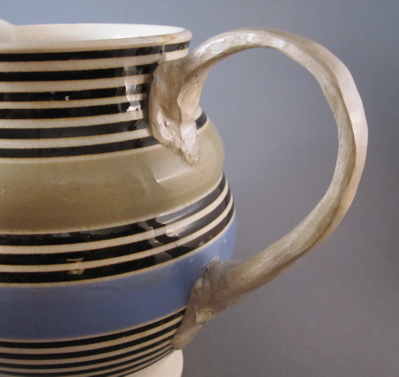

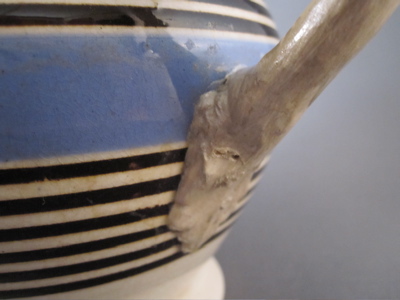
The original loop handle on my jug would have looked like the handle on the jug below with similar form and decoration.
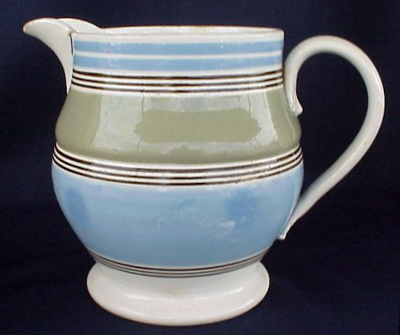
Photo courtesy of Burchard Galleries
Tags:English, metal handle, pottery
Posted in jug | 2 Comments »
Saturday, March 7th, 2015
This Chinese export baluster form milk jug with sparrow beak spout was made during the Qianlong period (1736-1795). The Mandarin style decoration of a child visiting a doctor or dentist while his parents look on is finely painted in the Famille Rose palette using polychrome enamels. Jug measures 5″ high
It is not uncommon to find 200 year old examples of Chinese porcelain with inventive repairs, as they were used daily and accidents happened. What makes this one extra special is the finely made silver replacement handle. It is more common to find replacement handles made of tin with support straps or bronze wrapped with rattan. But judging by the fineness of the repair, the owners were most likely wealthy and took their broken vessel to a silversmith who made this delicate replacement handle. The jug also has a metal staple stabilizing a crack near the rim, further proof of its early, rough life.
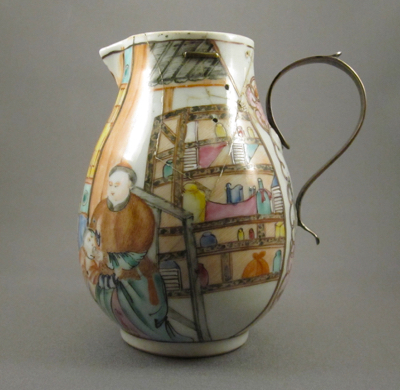
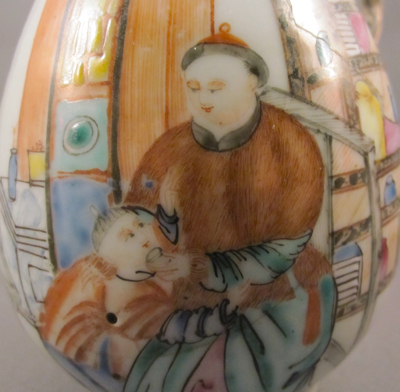
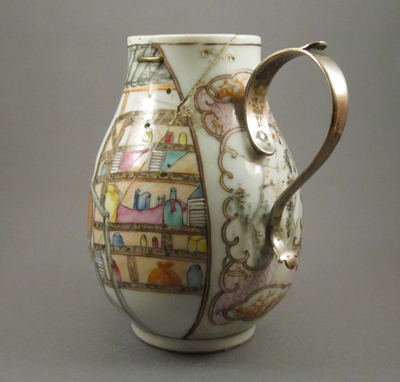
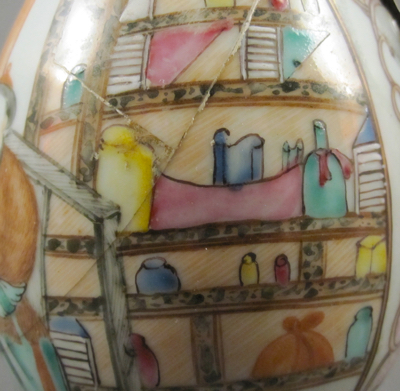
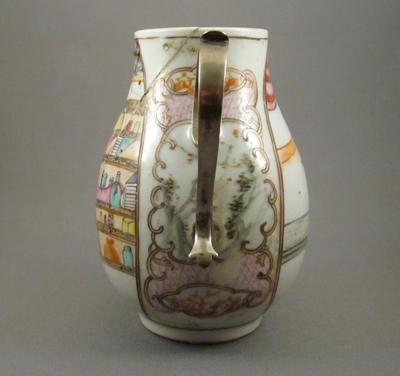

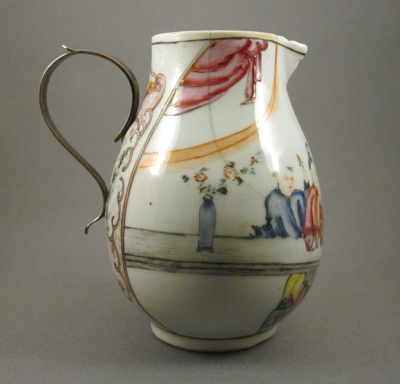

This jug of similar form and decoration shows what the original handle on mine would have looked like.
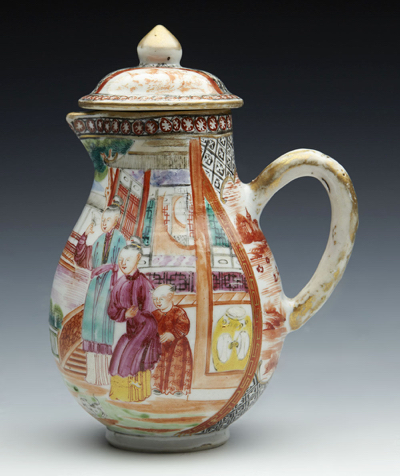
Photo courtesy of eBay
Tags:Chinese, Mandarin, metal handle, porcelain, silver
Posted in jug | 2 Comments »
Sunday, January 18th, 2015
I am a big fan of commemorative pottery, particularly ones with strong graphics and bright colors. Whenever I spot an example from afar in a shop, I secretly hope that it has some sort of inventive repair. Sometimes I get lucky. This creamware mug with printed transfer and hand colored decoration boasts the message “Peace of Europe Signed at Paris May 30, 1814.” Made in 1814 by Bristol Pottery in England to celebrate the signing of the peace treaty marking the end of war with France, this mug measures 4-3/4″ tall and 5-1/4″ wide to end of handle. Check out the details in photos showing the Bristol Pottery mark, the factory in the background, and ships with wood crates no doubt filled with pottery for export.
This mug possesses numerous battle scars, including chips, cracks, and the loss of its original loop handle. After the handle broke off, a 19th century tinker replaced it by drilling through the body and attaching a metal replacement with two square fasteners. To add insult to injury, the replacement handle is covered in rust, a result of further neglect. But if this mug were in “perfect” condition, I would not have purchased it.
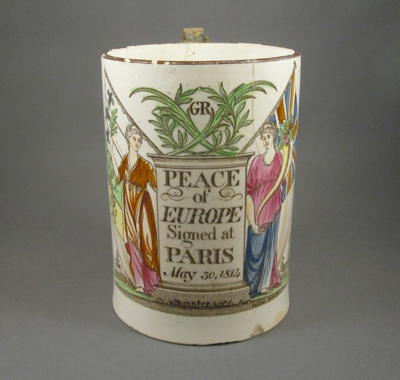
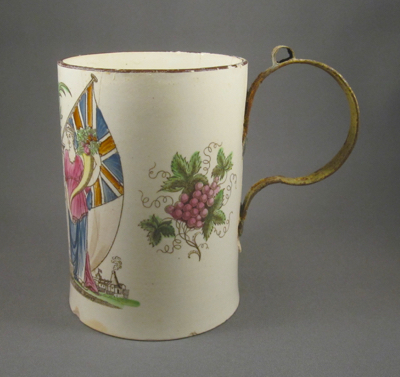
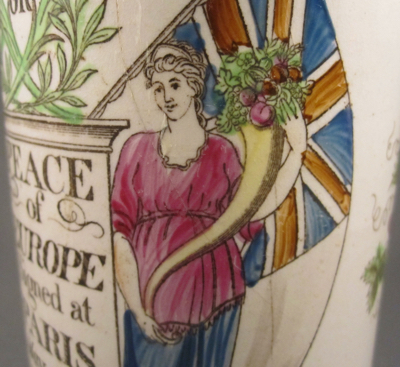
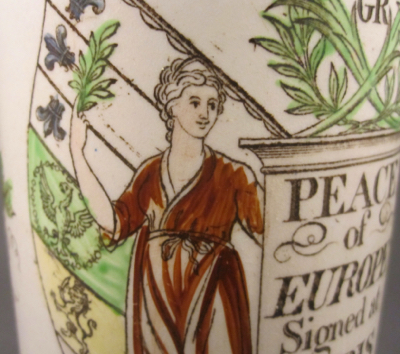
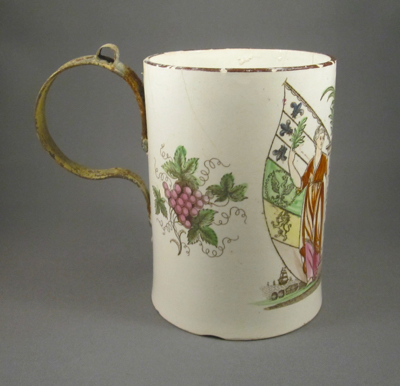


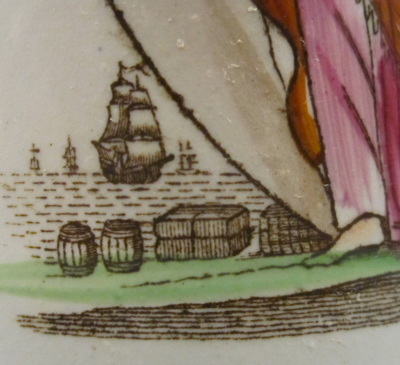
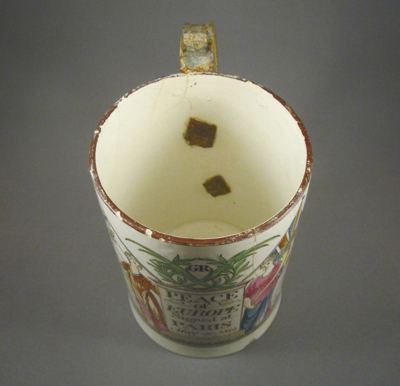
This example, with different copy and overglaze coloring, can be found in the collection of the British Museum in London.

Tags:commemorative, creamware, English, metal handle, pottery
Posted in mug/tankard | 4 Comments »
























































































